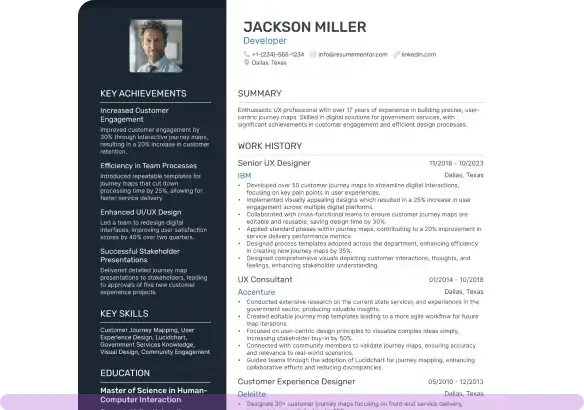How to Choose the Best Font for a Resume in 2025

Sep 25, 2024
|
12 min read
We reveal the good, the bad, and the ugly resume font options!
You’ve worked hard to create a dazzling resume. The content is on point, you’ve got an organized structure, and each section adds true value. Are you missing something? Choosing the best font for your resume is the cherry on top.
Since recruiters spend just seven seconds reviewing each resume, you need to make the right first impression fast. Using a professional resume font is the answer. It instantly sets the tone for your application and boosts readability, showing that you’re on the same page as the employer.
So, what’s the best font for a resume? In the following guide, we’ll be answering that burning question. Plus, we’ve got the ultimate list of the best resume fonts to use, too. Let’s dive into this topic.
Key takeaways for the best resume fonts
- Make the right first impression by choosing a font that speaks to your professionalism.
- Readability is your number one priority—make sure the font you choose is 100% clear.
- Align your resume font with the industry you’re in so it conveys the right message.
- You can mix and match two fonts on your resume but don’t overdo it.
- Finally, be sure to proofread your resume before you hit the “send” button. Small mistakes could cost you this job opportunity.
Why does font choice matter on a resume?
Before we take a deep-dive into choosing the best professional resume font, let’s talk about why it matters. There are a few reasons you need to perfect this art.
Let’s break down the main benefits of finding a good font for your resume:
Benefits of a professional resume font
- Readability: The number one priority is ensuring your resume is readable. Poorly chosen fonts can make the recruiter’s job harder than it needs to be. Ensure the font you choose is easy to read on both paper and screens.
- First impression: The reader doesn’t know you yet, and so they only have your resume to go on. Using a professional resume font gives the right impression and shows that you understand what the basic industry standards are.
- Professionalism: Your resume is a reflection of you. Choosing one of the best resume fonts conveys that you’re a real professional.
- Expectations: You don’t want your resume to stand out for the wrong reasons. Hiring managers expect to see specific fonts on resumes.
Recruiters will make a snap judgment on your resume based on its design, its content, and how easy it”s to read. Since you don’t have long to win them over, it’s worth spending the extra time choosing a good font for your resume.
Ahead of picking a font for your resume, there’s one quick decision you need to make.
Serif vs. sans serif: Which should you choose?
Serif fonts have small decorative strokes—known as ‘serifs’—and feet at the bottom of each letter. An example of this would be Times New Roman.
Sans serif fonts, on the other hand, don’t have these features. For example, Arial is a sans serif font.
Check out the main differences between these fonts below:
Which you use depends largely on the field you’re in. Serif fonts are associated with traditional careers, such as law and medicine. Sans serif fonts are more appropriate for modern fields, such as marketing.
Is your resume good enough?
Drop your resume here or choose a file.
PDF & DOCX only. Max 2MB file size.
Ready to get started? Next up, let’s take a look at some of the best professional fonts for resumes.
Nine of the best fonts for your resume
With more than 200,000 fonts in the world, selecting the right one can be a challenge. Don’t panic—we’ve narrowed down the list for you.
Here are nine of the best fonts for your resume:
Raleway
Modern and professional, Raleway draws inspiration from early sans serif fonts. That means that it’s easy to read and offers a contemporary aesthetic.
Raleway is suitable for a wide selection of modern resumes. If you work in a creative field—such as design or writing—this is one of the best fonts for your resume.
Rubik
With gently rounded corners and a geometric structure, Rubik is one of the most visually appealing fonts out there. The sans serif font is easy to read while also looking approachable and friendly.
Since Rubik is an inviting font, it works well for fields that have the same vibe. For example, you may choose this resume font if you work in teaching, social services, or non-profits, to name a few.
Lato
One of the most well-known sans serif fonts, Lato has subtle curves making it less geometric than other options. This font style remains easily legible and clear even at a small point size.
Lato is a popular choice among students and recent graduates. The resume font has a youthful appearance that suits modern fields and young professionals alike.
Bitter
Blending traditional and modern aesthetics, Bitter is what’s known as a ‘slab serif’ font. That means its main features are thick, block-like serifs.
If you’re looking to stand out from the crowd, using Bitter could be the answer. This is the best resume font for creative professionals, such as writers, illustrators, and artists.
Exo 2
Exo 2 is a geometric sans-serif font that has a good deal of space within the letters (for example, in the middle of the letter ‘o’). It’s known for being extremely readable, especially on screens.
Since Exo 2 is a versatile font, it’ll work for most professions and industries. However, it’s renowned for being an on-screen typeface. So, if you plan to send your resume as an attachment online, you might want to consider this font.
Chivo
Balancing geometric shapes and humanistic curves, Chivo offers a clean look with high levels of legibility. The accessible sans serif font works well whether it's on a screen or printed materials.
Professionals across a range of industries—business and finance to technology and creative fields—can benefit from using this resume font. Equally, if you’re trying to pack your resume with a load of information, the clarity of this font type makes it easy to do so without losing readability.
Montserrat
The epitome of modern typefaces, you can’t go wrong with Montserrat. The sans serif font has basic geometric shapes, giving it a sense of order throughout. It’s plain, simple, and does the job.
While professionals in any field can use Montserrat, it lends itself well to those in the technical sector. If you’re hoping to deliver a clear and professional aesthetic, it’s worth considering this resume font. The well-structured letters offer a high level of clarity, meaning that it’s always easy to read.
Oswald
Designed for screens, Oswald is a good choice if Chivo doesn’t float your boat. The typeface has relatively tall lowercase letters, which makes it clear even when you take the font size down. The bold design also features strong vertical strokes, and so this resume font always makes an impression.
Working in the technological sector? Oswald is your go-to resume font. This typeface is well-known within the tech industry and many hiring managers expect to see it on applications. However, if you work outside of this field, you can still use this font as it works well for digital formats.
Volkhov
Looking for a way to add a touch of elegance to your resume? You’ve found it. Volkhov is a traditional, serif font with some asymmetric strokes. This feature gives the font a sophisticated yet modern feel.
Effortlessly combining classic elements with a more contemporary approach, Volkhov will work well for most resumes. However, if you work in marketing, branding, or public relations, this is a real winner.
Now you know which font to choose, we’ll take a look at the best size.
What is the right font size for a resume?
Size matters when it comes to fonts. As a general rule, the standard font size for your resume content should be 12 pt. Bullet points can be slightly smaller, coming in at around 10 pt.
Of course, you need to ensure your headers attract attention. These can be 14 pt while your name and job title can be even larger than that. Above all else, make sure that you follow the same rules throughout.
Professional fonts vs. creative fonts: Which to choose?
Your resume font says a lot about you as a professional. It’s essential to send out the right message to the hiring manager. That begs the question: should you choose a professional or creative font?
Most of the time, you want to get the balance right. The fonts we’ve covered in this guide do that—fusing elements of classic typefaces with a contemporary twist.
You should also make sure your resume font aligns with your business. For example, if you work in graphic design or marketing, you can afford to add some creativity into the mix. But if you work in finance or law, you might want to play it safe and opt for a more conservative look.
Fonts to avoid on your resume
By this point, you’re well-versed in good fonts for your resume. But what about the bad and the ugly?
Yes, there are some fonts that you should avoid on your resume at all costs. Some fonts will make you look childish, out of touch, or even unprofessional.
Here are some of the resume fonts you must avoid:
Worst resume fonts
- Caveat Brush
- Courier
- Brush Script
- Comic Sans
- Lobster
- Pacifico
- Papyrus
- Permanent Marker
While you may be tempted to do something out of the box, resist that urge. It’s far smarter to choose a professional resume font than opting for one of the above.
Frequently asked questions
What is the most professional font for a resume?
We recommend using Lato, Raleway, or Montserrat.
Can I use more than one font on my resume?
Yes, you can! However, make sure that you pair the resume fonts well and only use two.
What font size should my name be on my resume?
The font size for your name should be between 20 and 24 points.
Conclusion
Choosing a professional resume font is vital to your job-seeking success. This is one of the first things that the hiring manager will notice when they review your resume. In this guide, we’ve shared the best fonts for your resume and advice on how to choose yours.
Make sure your font is readable and clear above all else and try experimenting with different styles, but always keep professionalism in mind.
Related Articles

Continue Reading
Check more recommended readings to get the job of your dreams.
Resume
Resources
Tools
© 2025. All rights reserved.
Made with love by people who care.










